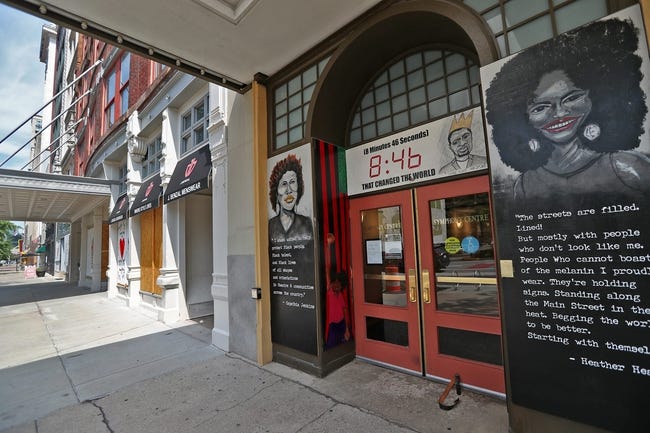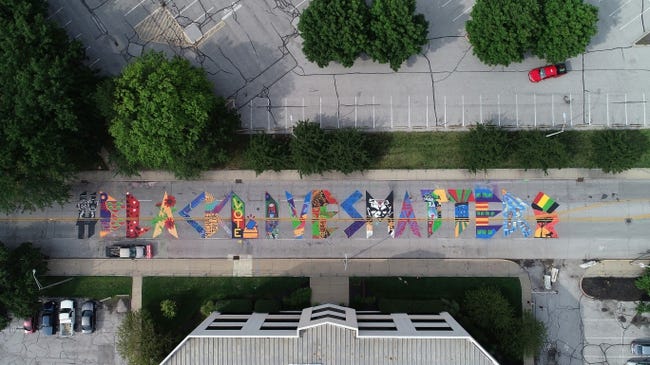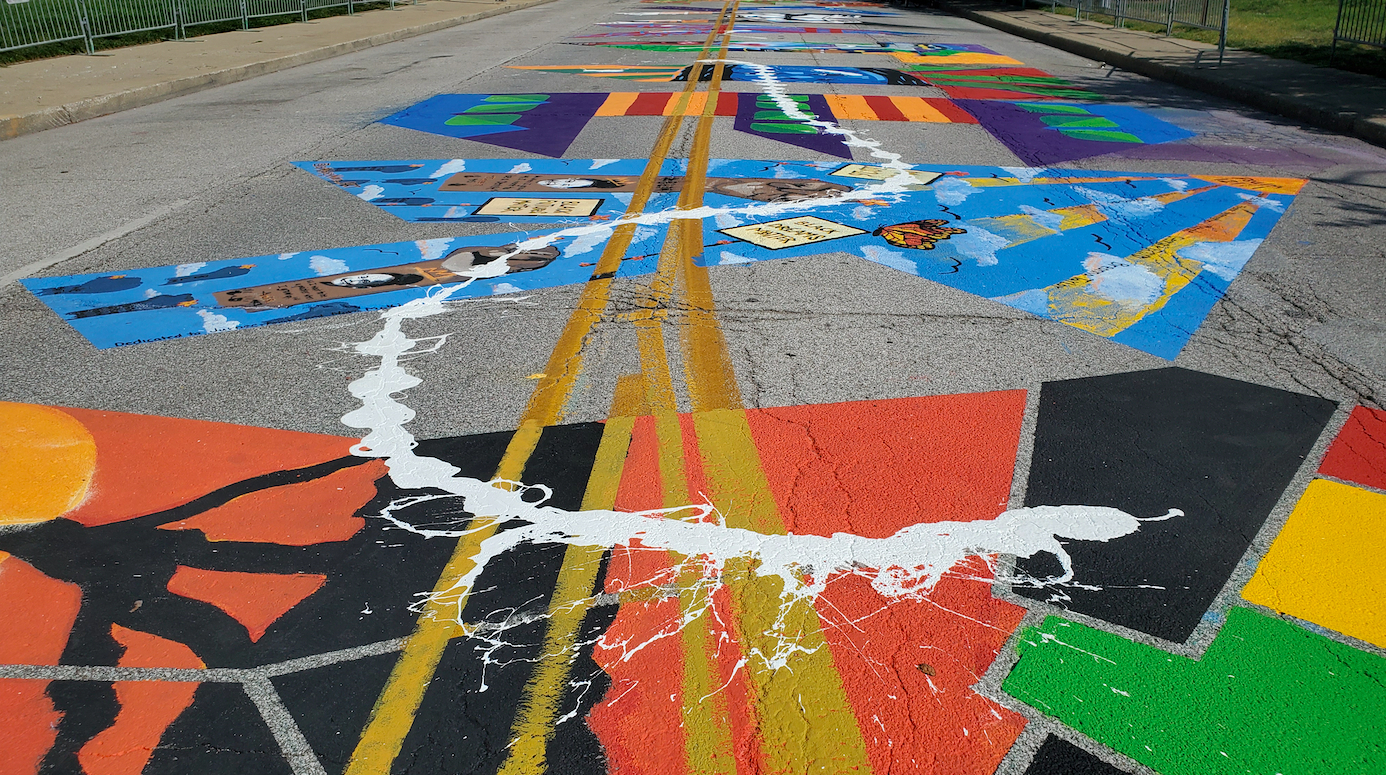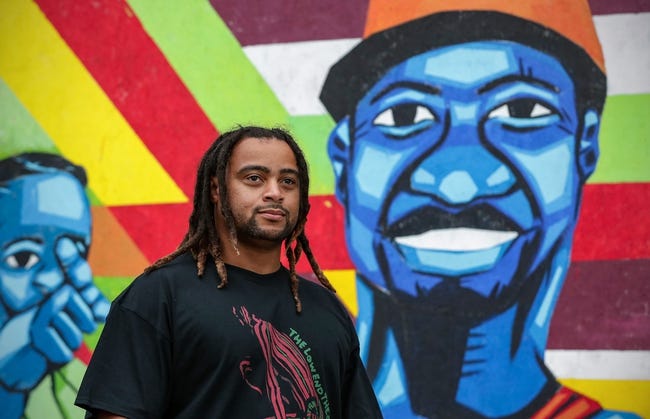Two mural projects emerged in Indianapolis following protests that erupted in downtown Indianapolis and other urban areas after the death of George Floyd in Minneapolis, on May 25, 2020. Protesters rose up against such deaths as Floyd’s and those of other Black citizens at the hands of police officers in Indianapolis and nationwide. The Murals for Racial Justice and the Black Lives Matters Mural projects started as immediate responses to these protests.
The two projects led to creation of the Eighteen Art Collective, organized by the artists involved in the Black Lives Matters Mural, and exhibitions that highlight the work of Indianapolis African American artists and their activism in the community.
Murals for Racial Justice

The teamed with the ; PATTERN, a local design company; Malina Jeffers Bacon, who later cofounded GANGGANG; and St’ArtUp 317 Incubator, an organization that works with the city to find space for Indianapolis creatives in vacant and underutilized real estate, to organize Murals for Racial Justice. For this project, the organizers commissioned 24 Black artists to create 22 temporary murals on storefronts that were boarded up in downtown Indianapolis following the 2020 summer protests.
Work began in June 2020. The original plan called for removing these murals from storefronts and placing them along the Indianapolis Cultural Trail. The plywood used to board up the storefront windows, however, proved unsustainable for long-term outdoor display of the artwork. PATTERN produced high-quality images of the murals to document the historic significance of the project. These images were used to produce 3-foot-by-5-foot vinyl banners that can be borrowed with a library card at at no cost. They also are available for study in the library’s online repository Digital Indy.

The physical murals are no longer in place. The mural by Matthew Cooper is on view at Old City Hall. The Indiana State Museum acquired Gary Gee and Mechi Shakur’s murals from the project for their permanent collection. Many of the murals have gone back to the artist who created them, and several were destroyed.
In addition to the murals, the project also included an artist professional development workshop series, hosted by Indy Arts Council, focused on building artistic growth and capacity. From November 2020 through May 2021, a series of “community circle” conversations were also held with the mural artists to start a dialogue about the meaning and practice of equity.
Black Lives Matters Mural
Indianapolis’ local Black Lives Matter group, Indy10, began to plan for a street mural in the wake of similar projects being painted across the U.S. following Floyd’s death. On July 13, 2020, the Indianapolis City-County Council approved resolution 198-2020 for the painting of a 30-foot tall Black Lives Matter Mural on , between West and Paca streets. The resolution was passed with 21 of 25 council members in favor of the mural.

The City of Indianapolis, through the coordinated with Indy10 and local funders such as former WNBA basketball player Tamika Catchings’ Catch the Star Foundation, the , and the to select and pay one Black artist to paint each letter of the mural on Indiana Avenue between the Indianapolis Urban League Center and the , a historic area for Black culture and life in Indianapolis. Organizers deliberately chose the site to remind people of both the historical and ongoing displacement of Black communities in this area of the city. In all, organizers chose 18 artists to paint the mural.
Kicked off with a celebratory event on August 1, 2020, actual painting of the Black Lives Matter Mural began two days later, on August 3. Names of Black people who have been killed by police and a reminder to vote, among other symbols, appeared inside the letters and characters. In addition to George Floyd, some of the names and faces included on the mural were those of Dreasjon Reed, fatally shot by an Indianapolis police officer on May 6, 2020; Breonna Taylor, shot in her apartment by police in Louisville, Kentucky, on March 13, 2020; and , shot and killed on September 24, 1987, while in the custody of the .
Just one week after the mural was painted, it was defaced with splatters of white and gray paint. A spokesperson for the artists called the hateful act a demonstration of how effective they had been in conveying the ongoing nature of displacement of Indianapolis’ Black citizens in their work.
The mural remained on Indiana Avenue in its defaced condition until the cultural development firm GANGGANG; Stacia Murphy, director of Equity Outreach & Strategic Partnerships at the ; the Eighteen Art Collective; Indy10 Black Lives Matter; and Kären Haley, executive director of the Indianapolis Cultural Trail developed a new plan for the mural, out of necessity.

Construction on Indiana Avenue to accommodate the expansion of the Indianapolis Cultural Trail required the removal of the Black Lives Matter Mural from its 15-month home. The two-mile extension of the trail from the Madam Walker Legacy Center to the Innovation District required repaving the portion of Indiana Avenue that included the mural. However, construction crews involved in the trail expansion meticulously saw cut a square foot of each of the 18 letters, including the hashtag and fist, for the artists to keep. On October 2, 2021, before the saw cutting, the city closed the mural section of Indiana Avenue to give the artists, collaborators, and the community a chance to spend time with the art before the trail expansion effort began in earnest.
Discussions about how to honor the mural in the future are ongoing. Some have considered museum exhibits, another mural, or a memorial to the original one. GANGGANG aims to create a more permanent Black Lives Matter art installation on Indiana Avenue, if possible.
Continuing Impact
The mural projects sparked the creation of several exhibits across Indianapolis:
- The collaborated with the Indy Arts Council to work with several mural artists, including some involved in the Murals for Racial Justice project and others who created murals independently for its 2021 exhibition, Response: Images and Sounds of a Movement.
- In 2021, Israel Solomon, who had participated in the two mural projects, and Matthew Cooper, whose work appeared in the Murals for Racial Justice, went on to create the Art and Activism exhibit at the Art Council’s Gallery 924.
- A year-long exhibition opened at on September 23, 2022, to highlight the continuing work of the Eighteen Art Collective. The exhibit featured about 20 of their artworks.

The Murals for Racial Justice and Black Lives Matter murals both provided a space for immediate response by the Indianapolis community to share in their frustrations, grief, and hope. Their impact, however, continues beyond the lifespan of the murals. Not only did the artists involved gain increased visibility and recognition for their individual work, but the projects helped spark the creation of new spaces for Black artists to grow and be seen in Indianapolis.
FURTHER READING
- Digital Indy. “Murals For Racial Justice Collection.” Accessed October 8, 2025. https://www.digitalindy.org/digital/collection/murals.
- Eighteen Art Collective. “Black Lives Matter: The Mural.” https://www.18artcollective.com/theblacklivesmattermuralindianapolis.
- The Children’s Museum Indianapolis. “Black Lives Matter Mural.” https://www.childrensmuseum.org/exhibits/100-Stories/black-lives-matter-mural.
CITE THIS ENTRY
APA:
Verderame, J. A. (2022). Black Lives Matter Murals. Encyclopedia of Indianapolis. Retrieved Jan 5, 2026, from https://indyencyclopedia.org/black-lives-matter-murals/.
MLA:
Verderame, Jyoti A. “Black Lives Matter Murals.” Encyclopedia of Indianapolis, 2022, https://indyencyclopedia.org/black-lives-matter-murals/. Accessed 5 Jan 2026.
Chicago:
Verderame, Jyoti A. “Black Lives Matter Murals.” Encyclopedia of Indianapolis, 2022. Accessed Jan 5, 2026. https://indyencyclopedia.org/black-lives-matter-murals/.

Help improve this entry
Contribute information, offer corrections, suggest images.
You can also recommend new entries related to this topic.